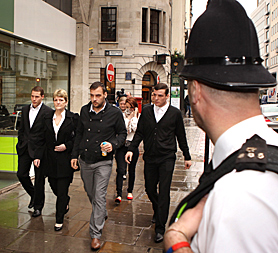G20 death: Home Office pathologist contradicts Dr Patel
A Home Office pathologist, the second to conduct a post-mortem on Ian Tomlinson, rejects Dr Freddie Patel’s finding that the newspaper salesman died of natural causes. Simon Israel reports.

A top pathologist has told the Ian Tomlinson inquest that the news vendor did not die of a heart attack at the G20 demonstrations.
Dr Nat Carey said Mr Tomlinson’s death was the result of internal bleeding caused by a traumatic blow to his liver, which he said – having viewed all the cctv footage – was likely to have been triggered by his fall to the ground when shoved by a police officer. He dimissed as highly unlikely another pathologist’s view that coronary disease brought on a heart attack which killed the 47 year old father of nine. Mr Tomlinson died two and a half minutes after he was struck with a police baton and subsequently pushed to the ground by PC Simon Harwood.
Giving evidence for the first time at the inquest, Dr Nat Cary said Mr Tomlinson died of internal bleeding.
Dr Patel, who performed the original autopsy in 2009, has continued to insist to the inquest that he had found no “causal evidence” to contradict his finding that Mr Tomlinson’s death was related to his coronary heart disease.
Mr Tomlinson collapsed and died shortly after being struck by a police baton and being pushed to the ground as thousands took to the streets in the G20 protests.
Dr Cary was instructed by the Independent Police Complaints Commission (IPCC) and Mr Tomlinson’s family. He performed his examination of Mr Tomlinson’s body six days after Mr Patel, and said today that he had agreed with Dr Patel’s ruling on external injuries.
He disagreed with Dr Patel’s internal findings, but Dr Cary said today that in fairness to Dr Patel, he had been watching the news and knew in advance that Mr Tomlinson had fallen after being pushed by police.
Special report: Ian Tomlinson inquest
Dr Cary said: “I suppose the most important information I had was that clearly Mr Tomlinson had been involved in police contact shortly before he collapsed. And I don’t think that was known to Dr Patel at the time he carried out his examination.”
Our Home Affairs correspondent Simon Israel reports from the inquest:
While Dr Patel had found minor bruising to the liver, Dr Cary told the inquest he found the injury to be 3cm deep.
He said: “It just makes the point this is not some trivial mark within the liver. This is a bruised liver. It has deep bruises within it that run right up to the surface of the liver.”
Dr Cary said he could not find any other source of bleeding to the abdomen, though he admitted: “It doesn’t mean it wasn’t present”.
The damage to Mr Tomlinson’s abdomen could have been caused by “blunt force trauma”, Dr Cary said.
Questioned over his findings in court yesterday, Dr Patel said there was a “compelling” association between trauma and a heart attack, but there was no “causal evidence” that Mr Tomlinson suffered a heart attack triggered by his “stressful” altercation with PC Simon Harwood.
Dr Patel said: “Partly that diagnosis is made on the basis there is no alternate explanation at the time of my examination to explain death.
“There was no major injury to any organs or blood vessels that could produce in a short period of time sufficient bleeding to cause death.”
Dr Patel left the inquest this morning due to illness.